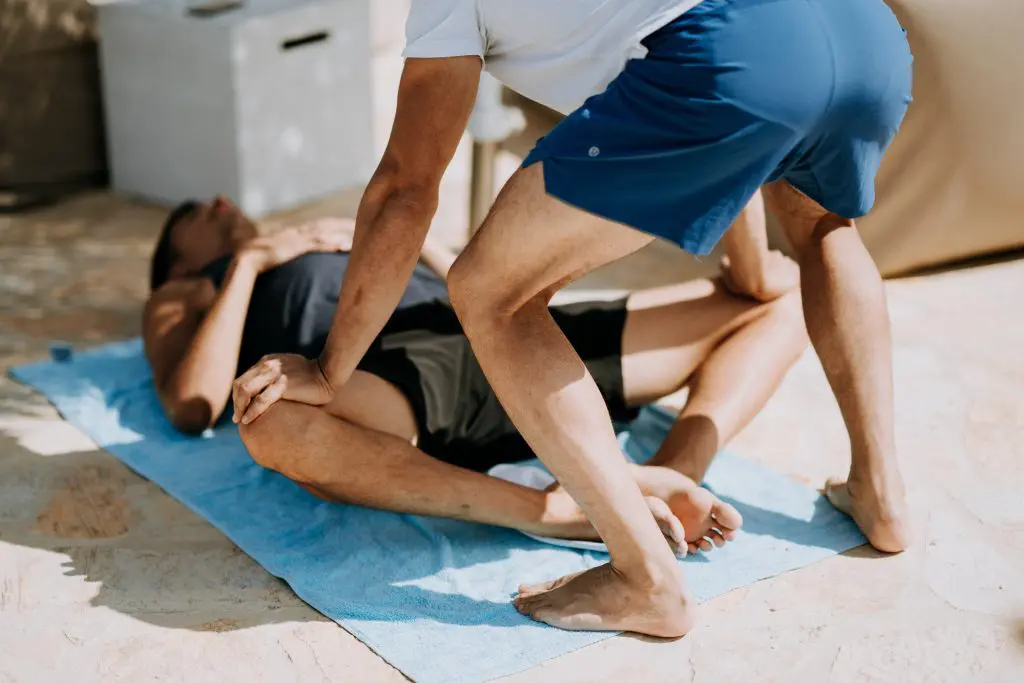How to Relieve Shin Splints While Playing Basketball
There is, perhaps, nothing quite as bad as having shin splints while playing a game of basketball. Where one minute you were running up-and-down the court, to the next you’re kneeled over grabbing your shin, wincing in pain.
While shin splints are painful, and detrimental to your game, there are some steps you can take to both avoid and relieve them. Below we are going to discuss how to relieve shin splints while playing basketball and steps you can take both before and during the game to avoid their occurrence.
However, it is important to note that I am not a doctor nor is this medical advice. If you are experiencing painful shin splints, then we recommend you see a doctor or a trained medical professional. The advice contained within this post is only for informational purposes and is not meant to be used as medical advice.

What Are Shin Splints?
Medically, shin splints are known as medial tibial stress syndrome. Shin splints often occur in athletes who are engaged in high intensity exercises and trainings. This not only includes basketball, but can also occur in sports such as running, dancing, and even in the military.
Typically, shin splints refer to pain along the tibia or shin bone. That is the large bone in the front of your lower leg. Many times, shin splints can be self-diagnosed, with athletes reporting tenderness, soreness, and pain along the inner side of the shinbone and mild swelling in the lower leg.
However, as a basketball player, you are typically at a higher probability to both encounter and suffer from shin splints. This is due to the stress caused from running on both hardwood and concrete basketball court surfaces. In addition to the stress caused from regular play, newer players to the game are at a higher probability to suffer from shin splints due to the stress of the game.
In addition, if you recently undertook a basketball regimen, particularly a high intensity one, then you may suffer from shin splints. Similarly, running and playing basketball on an uneven or hard surface can increase the likelihood of your suffering from shin splints.
How to Relieve Shin Splints After Playing Basketball
While shin splints are a common occurrence, with 4-19% of the athletic population admitting to suffering from the condition, there are some steps you can take to both help prevent their occurrence and relieve their symptoms. Below, we are going to review some ways you can relieve and prevent shin splints while playing a game of basketball.
Firstly, you should utilize the RICE method. The RICE method is a common method and approach to treating injuries at home and may help you to relieve the pain associated with shin splints. The RICE method stands for rest, ice, compression, and elevation.
- Rest – perhaps the most important first step after suffering from a shin splint is to rest. You should take some time away from strenuous activities and exercises, allowing your body the time it needs to fully heal from the injury.
- Ice – similarly, icing your shins for 15-20 minutes will help to reduce the swelling in your shins. Wrap ice in a towel and place on your shins between four to eight times a day, for several days until the pain in your shins begins to subside.
- Compression – utilize compression sleeves or other material to help reduce the inflammation around your shins.
- Elevation – lastly, be sure to elevate your shins while icing them. You can do this by laying on a couch with your shins elevated with pillows or a nearby chair or ottoman. Doing so well also help to reduce any inflammation you are feeling.

How to Prevent Shin Splints While Playing Basketball
While the above information is useful for relieving shin splints after a game of basketball, there are some steps you can take to prevent shin splints while playing a game of basketball. Of course, doing so will not guarantee the prevention of shin splints, but can help to reduce the probability of a shin splint occurrence.
- Analyze Your Movements – if you notice that you are suffering from shin splints after a certain movement or exercise, whether on the basketball court or during an exercise routine, then you should look to either change that movement or refrain from it all together. Similarly, you can adapt your body’s movement, looking to avoid that pattern or begin to move in a manner that places less stress on your shins.
- Don’t Overdo It – while we all like to put in 100% during a game of basketball or during practice, you should look to lower your intensity levels if you continuously suffer from shin splints. While disheartening, it is much better to reduce the likelihood of suffering from a shin splint or other injury, even if that means putting in 90% of your potential.
- Choose the Right Shoes – your shoes play an integral part in reducing the occurrence of shin splints. Consider investing in basketball shoes which fit correctly and don’t be afraid to replace those shoes every few months.
- Consider Arch Support – both arch support and shock-absorbing insoles can help you to reduce the stress you place on your shins. This is particularly true if you have flat feet. Arch support and shock-absorbing insoles can help you to reduce stress to your feet and leg muscles and can be purchased at your local supermarket or pharmacy.
- Stretch Before Engaging in Physical Activity – one great way to prevent or reduce the likelihood of shin splints while playing basketball is to stretch beforehand. Be sure to stretch the muscles in your lower legs and shins, helping to reduce tension and stiffness.
- Engage in Less Impact Exercises – while training or exercising for basketball typically occurs on the basketball court, you can also train in a pool or on a bike. Doing so places less stress on your shins and helps to prevent the likelihood of a shin splint.
- Engage in Strength Training – another great way to prevent shin splints is to engage in strength training of the legs, ankles, and hips. Doing so will help your legs and shins to deal with the high impact associated with a game of basketball.
